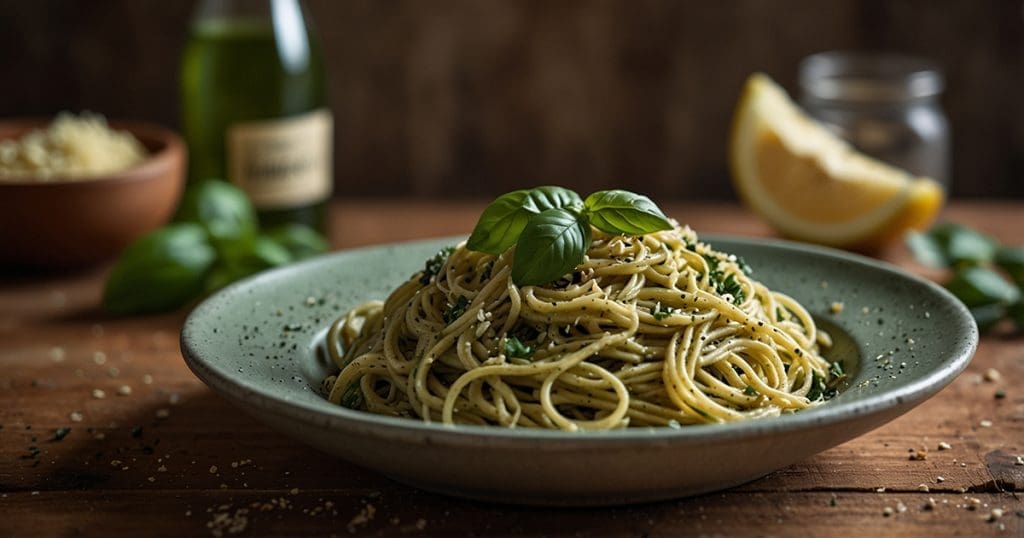Introduction to Pesto Pasta
Pesto pasta is a classic Italian dish known for its fresh, aromatic flavors and simple preparation. Pesto, the vibrant green sauce, made from basil, garlic, pine nuts, Parmesan cheese, and olive oil, coats al dente pasta perfectly. This dish has its roots in Genoa, Italy, where ‘pesto alla Genovese’ has been a staple for centuries. Over time, variations of pesto have emerged, incorporating ingredients like spinach, walnuts, and even sun-dried tomatoes. In this guide, we’ll break down everything you need to know about making restaurant-quality pesto pasta at home.
Essential Ingredients for Perfect Pesto
Authentic pesto relies on high-quality ingredients. Fresh basil leaves provide the signature aroma and taste, while pine nuts add a nutty depth. Extra virgin olive oil ensures a rich texture, and Parmesan cheese gives the sauce its umami-packed sharpness. Garlic enhances the bold flavors, and a touch of lemon juice can brighten the overall dish. If pine nuts aren’t available, walnuts or almonds make great substitutes. Using fresh, organic ingredients elevates the final dish, ensuring an unforgettable homemade pesto pasta experience.

Step-by-Step Guide to Making Pesto
Making pesto from scratch is quick and easy. First, toast the pine nuts in a dry pan for a few minutes to enhance their flavor. In a food processor, blend fresh basil, garlic, toasted pine nuts, and grated Parmesan. Slowly drizzle in olive oil while blending to achieve a smooth consistency. If the pesto is too thick, a little warm water can help loosen it up. Season with salt and pepper to taste. Store-bought pesto can work in a pinch, but nothing compares to homemade pesto’s vibrant taste and aroma.
Cooking the Pasta to Perfection
The key to great pesto pasta is perfectly cooked pasta. Start by boiling water with a generous amount of salt—it should taste like the sea. Cook the pasta until it is al dente, following the package instructions. Reserve some pasta water before draining; this starchy water helps emulsify the pesto, creating a smooth, silky sauce. Toss the hot pasta with the pesto, adding a little reserved pasta water to coat every strand evenly.
Best Pasta Types for Pesto
While spaghetti and linguine are popular choices, short pasta like fusilli, trofie, or penne work exceptionally well. These shapes hold onto the pesto sauce, ensuring every bite is flavorful. Traditional Genovese pesto is often paired with trofie pasta, a small, twisted pasta that holds the sauce beautifully. Feel free to experiment with different pasta types based on preference.

Creative Variations and Add-Ins
Pesto pasta is incredibly versatile. Add cherry tomatoes for a burst of sweetness, grilled chicken for protein, or roasted vegetables for extra depth. A touch of red pepper flakes can add heat, while burrata cheese creates a creamy contrast. Experimenting with different nuts, such as pecans or cashews, can also introduce new flavors to your homemade pesto.
Final Touches and Serving Suggestions
Once your pesto pasta is ready, top it with extra Parmesan, fresh basil, and a drizzle of olive oil for added richness. Serve alongside garlic bread or a fresh salad for a complete meal. Pairing it with a crisp white wine, like Sauvignon Blanc or Pinot Grigio, enhances the dish’s fresh flavors. Pesto pasta can be enjoyed warm or as a cold pasta salad, making it a perfect dish for any occasion.
What’s your favorite pesto variation? Do you prefer traditional or a creative twist?


![Ground Beef Taco Salad [recipe]](https://b3860431.smushcdn.com/3860431/wp-content/uploads/2024/04/Ground-Beef-Taco-Salad-Recipe-1024x538.jpg?lossy=2&strip=1&webp=1)
![Canned Biscuits Pull-Apart Garlic Bread [recipe]](https://b3860431.smushcdn.com/3860431/wp-content/uploads/2024/04/Canned-Biscuits-Pull-Apart-Garlic-Bread-Recipe-1024x538.jpg?lossy=2&strip=1&webp=1)
Facebook Comments